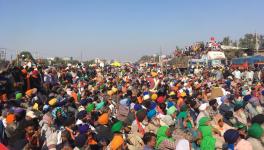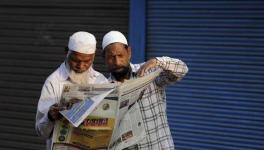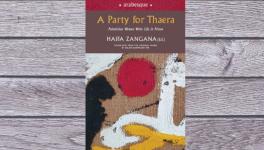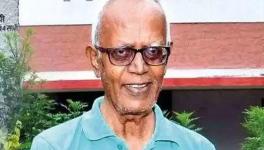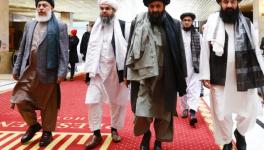The Macabre Measure of Dalit-Bahujan Mobilisations
Another Dalit girl is dead after being brutally raped, tortured and mutilated by upper caste men (Thakur caste belonging to the savarna Kshatriya varna) on 14 September in Hathras village in Uttar Pradesh, where ten rapes are committed every day according to official statistics, while many others go unreported.
Hereby, another human identified as untouchable by the subcontinent’s millennia-old racist, slave-driving, segregationist order of caste has been reduced to her immediate identity and nearest possibility, in the immortal words of Rohith Vemula, written just before his institutional murder, to describe the way his university reduced him, too, to his Dalit identity.
The 19 year old girl died on 29 September under the following conditions: the severity of assault, the delay in receiving appropriate treatment for her torturous wounds at a leading public hospital in Delhi, and the neglect of the policemen to whom she had made a clear dying declaration of her sexual assault and the perpetrators’ identities.
Her death too is an institutional murder. But the character of this institution which oppresses, enslaves, tortures, traffics, rapes, mutilates, and murders has to be examined closely to the point from which the condescending and duplicitous gestures of this institution should no longer be repeatable.
The unabashed and manifestly illegal effort of the upper caste police administration, obedient to an upper caste chief minister (himself a Kshatriya) of an upper caste party (directed by a Brahmin organisation, the RSS), was: to hurriedly declare an absence of sexual assault even before trial had begun, and despite the final testimony of the victim and the medical report of the first hospital; and to destroy evidence by cremating the body at 3 am without the consent or presence of the girl’s parents and siblings.
“हमारी बहन को कचरे की तरह जलाया गया”, our sister has been burnt like waste—saying this, Chandrashekhar Azad, chief of the Bhim Army, an organisation of, by, and for Dalit-Bahujans, named the essence of this choreography of actions which would have been impossible if the victim were an upper caste girl. He did so on 2 October, the birth anniversary of MK Gandhi who was a defender of the caste order and who preferred that the people of the untouchable manual scavenging caste should voluntarily embrace the profession to which they were already condemned by birth, and should strive for excellence in cleaning shit.
It is impossible to overlook the political posturing and manoeuvrings that are still played out in Gandhi’s name by what is liberally called the left and of late the Hindu right, who are both committed to the “Hindu” upper caste dominance of Indian society.
That this pattern manifests itself most acutely in Uttar Pradesh has everything to do with this state being the core component of the “Hindi-Hindu-Hindustan” belt, that is, the north-western region of India with the maximum expression of the drive for a nation whose language, religion and social structure strictly correspond to an Aryan identity. India as a “Hindu” nation that will revert to the glory of the Aryan supremacy, which in reality is the supremacy of the upper castes of Brahmins, Kshatriyas, and Baniyas, has been constructed predominantly from the north-west Indian perspective.
Uttar Pradesh has a large upper caste population which has held political, administrative and cultural power for the largest part of the period before and since the transfer of power in 1947. The largest number of members of parliament are returned from this state. The newspaper with the highest circulation—in Hindi language and promoting the upper caste project of a Hindu nation—is run from Uttar Pradesh. Rajasthan and Madhya Pradesh, which are the other significant constituents of the Hindi belt, also record very high rates of crimes against Dalit-Bahujans and against women in general.
The treatment of the victim, leading to, in, and after her death, has faithfully exhibited the millennia-old attitude of the upper castes towards those they enslaved and segregated. This phenomenon is ubiquitous and very well-known but deliberately unacknowledged in the Indian Union for reasons that themselves pertain to the perpetuation of the caste order.
In the early 2000s, the pattern of crimes against Dalit women and their oppression through both quotidian and grievous acts, was meticulously researched and documented; these country-wide findings were published in 2011 in a book, accurately titled Dalit Women Speak Out, edited by Aloysius Irudayam SJ Jayshree, P Mangubhai, and Joel G Lee. They analysed then what is still recurring with ceremonial regularity, most acutely in Uttar Pradesh and Rajasthan:
“Dalit women are more likely to face collective and public threats or acts of social violence than dominant caste women, who tend to be subjected to violence more within the family due to strict controls over their sexuality and freedom of movement.”
Irudayam et al revealed the essential character of caste-based crimes—they are in fact punishments dispensed by the upper caste guardians of the caste order to Dalit women “when they transgress caste norms, such as those relating to caste endogamy or untouchability, or assert their rights over resources: public or cultural spaces”. It is not by negligence or corruption, but rather with great care that these acts of punishment follow a norm which is outside that of the Constitution of India and the criminal code, from which these acts are shielded with great care. Dalit Women Speak Out had exposed this “procedure” a decade ago:
“An unofficially established trend exists today of police collaborating with dominant caste perpetrators to file false cases against the Dalit women or their families in order to pressurize them to withdraw cases or make out-of-court settlements. In many instances Dalit women are threatened into compromises or forced to become hostile witnesses to ensure a case acquittal.”
These deadly crimes happen with a regularity that is indifferent to the laws and norms of the world. They annihilate a person’s capacity for becoming anything different from what the caste order dictates for them. Its aim is to guard against the future liberation of the Dalit-Bahujan and a possible representation of this real majority community in politics. For this, the guardians of the caste order send out terminators of all kinds equipped with all the new technologies—the modern police system, the judiciary, the social media, the academia, latest social science disciplines and theories.
It is a well-known “secret” that the upper castes are a severe minority population of the subcontinent which has been oppressing the majority population, the Bahujan. The falsity that there is one religion of the majority population of India—a falsity that would soon be baptised as “Hindu” religion—exposed as early as 1855 in an essay by Mukta Salve, a teenaged pupil of the Phules’ school, which has been rightly hailed as perhaps the first feminist text of India. She wrote:
“If the Vedas belong only to the brahmans, then it is an open secret that we do not have the Book. […] then we are not bound to act according to the Vedas. […] Let that religion, where only one person is privileged, and the rest deprived, vanish from the earth and let it never enter our minds to boast of such a (discriminatory) religion.”
Since the mid-nineteenth century, Dalit-Bahujan have been mobilising to annihilate caste. Progressive views and reforms for women’s equality were first envisaged and implemented in the form of girls’ schools by Jotirao Phule. Long before Gandhi was even born, Phule said:
“In their opinion, women should forever be kept in obedience, should not be given any knowledge, should not be well educated, should not know about religion, should not mix with men, and they bring out extracts from our Shastras in which women are so deprecated in support of these idiotic beliefs, and ask whether anything written by the great and learned sages be untrue.”
Neither these transformative achievements nor the strenuous counter-efforts of the upper castes to obstruct them have been taught in our history textbooks. Instead, we have all suffered an arrested political and intellectual development due to the brazenness of the upper caste fantasy that our current problems are the remnants of colonial rule.
This most malicious and elaborate fantasy also goes by the name of postcolonialist theory, whose proponents are nearly all upper caste. It is the project to recover the lost pride of the upper castes who lost control of their traditional powers over the lower castes during British rule. It is the enemy of any attempt to emancipate the majority of the subcontinent from the oldest indignity, inequality and oppression of the caste order. Postcolonialist study of contemporary India is a witness to something that has no objective reality, a mock fight against a spectre that is no longer haunting anyone.
The upper castes have been interposing themselves in the place of Dalit-Bahujans to “speak for them” and even for their alleged “subaltern” inability to speak for themselves. It is not that the Dalit-Bahujan do not speak, but rather that their speech is made to disappear. Besides minimising the history of the lower castes—who were neither abject nor subaltern but were rather the pioneers and participants in an enlightenment that is still dawning on the subcontinent—the upper castes have cunningly practised several other strategies of erasure in politics and the public sphere:
An intellectual obligation has been imposed to treat the category of “caste” as a colonial construct. All discussion of our social reality is forced to look for its adequate terminology and truth in the Brahmanical terms from various periods like “shudra” or “harijan” (children of Vishnu) rather than in the experience of reality that the lower castes have had or the political identities they forged for themselves, like “Dalit”. The more recent Brahmanical imposition has come in the form of the term “subaltern”; the use of “internal colonialism”, a convoluted analogy of foreign rule to describe caste; the term “vertical diversity” as another perverted euphemism for caste, to give it a positive spin; and the demand that Indian feminist should prefer Draupadi, the Kshatriya heroine of a Sanskrit epic, as an icon for their plight. Similarly, caste atrocities are evaluated from an upper caste perspective, such as ‘could Bhanwari Devi have been raped by upper caste men since she was untouchable?’ The government of the upper castes has recently prohibited the media from using the word “Dalit”.
Most important in the present context is the cunning of Indian feminists who rejected European feminism by saying it was only concerned with white women and that it colluded in the colonialist oppression of brown men and women. Thus upper caste women became self-appointed representatives of all women, but they in fact addressed only their own concerns and hid the problems of caste and of Dalit-Bahujan women and men.
Anu Ramdas occasioned a necessary reflection and debate on whether “feminism is Brahmanism” when we observe that the canon of feminism did not represent any Dalit-Bahujan voice or material concerns. The upper caste discourse erased the fact that Phule was making feminist demands avant la lettre [before the concept existed], and decades before upper caste feminists, and he had not tried to advocate the equality of lower caste women alone but for all women. For him gender came before community, as Tejas Harad has pointed out. But not for Indian feminists: when they were reminded of their prejudice, most recently in the moment of Raya Sarkar’s list, their response was through anger and self-praise. But feminism has already been criticalised by Dalits, who exposed the fact that on the subcontinent gender comes after community and that postcolonial feminists are upper caste first and women later.
When Dalit scholars and activists spoke about the intersecting and compounding relations between caste and gender, the upper caste feminists sought to discredit “intersectionality” as an imported term—perhaps they expected everyone to accept their postcolonialist common sense that “foreign” knowledge, especially of Black feminists, is bad and upper caste feminists’ thoughts are more acceptable because they are indigenous and “pure”. Priyanka Samy has once again patiently outlined “the interesting factors behind structural violence against Dalit women” in the Hathras case. For such reasons, the new discipline of “women’s studies” practised by upper caste feminists has alienated Dalit students. Rupali Bansode articulated their scepticism, writing that “Dalit girls feel there is nothing called ‘Sisterhood’”, nothing called ‘Oneness’, rather they feel excluded always”.
Moreover, upper caste scholars and commentators in the public sphere regularly appropriate the very emancipatory discourse of the lower castes to talk about them. Many of the theoretical breakthroughs of the Dalits have been appropriated and folded into a discourse which the upper caste scholars can wield and direct, even as others have been discredited. The foremost instance of this was the effort to prevent Dalit activists from raising the issue of caste-discrimination at the United Nations World Conference Against Racism and related discriminations at Durban in 2001. Theirs and every later attempt to discuss caste and racism in the same breath was dealt with savarna-splaining and condescension by many leading sociologists and political scientists.
Another recent example, in the media, is the Hathras case in which the Bhim Army, the very organisation of Dalits themselves which had first started massive protests in Delhi was given last priority in reportage as well as in access to the family of victim. Its leader, Chandrashekhar Azad “Ravan” was the first to raise the matter to the necessary point where it could not be ignored or buried. Yet, he was the last to be permitted to meet the victim’s family, after the leaders of the Congress (although it was commendable that they and other opposition parties took up this issue).
Caste is the only political problem of the sub-continent. All spheres of activity—business, judiciary, army, politics, media, academics, art, literature—are controlled and dominated by the upper castes, keeping the Dalit-Bahujan in an “underworld” where they have no representation and participation even though they are the real majority. Using this control and for the sake of maintaining it, the upper castes have created an alternative reality in which caste is seen as a thing of the past. For many decades they even succeeded in wasting much breath on discussing is caste a reality in 20th century India? Or has caste withered in the 21st century? Or why bring caste into an incident which is simply violence of a Hindu against another Hindu? More recently, instead of fighting the well-known reality they have taken to broadcasting their own uncertain awakening. Uncertain since it is still snuggled in devious apologetics and diffractions of casteist reality.
For instance, many people have been outraged by the Hathras incident in a specific way suggesting that the main problem was whether Opposition or media can access the family or not—whereas the problem is recurring because it is systemic. Many upper caste commentators in various domains have analysed the incident predominantly in terms of patriarchy, police irregularity, goonda raj lawlessness in Uttar Pradesh, Hindu nationalism, colonial remnants—this last will need special attention—and with as little reference to caste as can be gotten away with. This is also consistent with those looking for solutions in the judicial system, demanding—from whom?—a 100% conviction rate. They know that the outgoing chief justice of India was accused of sexually exploiting a Dalit employee of the Supreme Court, and he was able to preside over her compliant himself, and judged it to be false. He was thereafter made a nominated member of Parliament. Some even asked for presidential rule which would be more of the same Aryan supremacist rule as currently in Uttar Pradesh, both being controlled by the BJP-RSS.
All these institutions have been serving upper caste interests—as also revealed in the way that the few progressive anti-caste laws are being diluted. These include provisions related to the very SC/ST Prevention of Atrocities Act under which the perpetrators of Hathras were finally arrested. Also being diluted are the provisions of reservations, which were restricted to “Hindus” so as to prevent them from converting to other religions, and also to prevent the Dalit-Bahujan of other religious communities from receiving the constitutional guarantee of reservation. The ideals of just institutions are unachievable until the majority finds representation in them through membership rather than trusteeship or proxy.
The caste order works to convert all men and all means into one sole end—perpetuation of the caste order. Like Calypso in the Greek legend, it seeks to hide or avert everyone who is on and from the subcontinent from actualising the fundamental homological powers of humans to become something different from what they are or what they are born as. It is stasis—a conversion to end all conversions—it interns and inters. It is the most perfected calypsology known in history, the longest lasting form of racism. It is the death mask. This can be quickly observed through a contrast:
Michel Foucault, in his project Lives of Infamous Men, attempted to demonstrate the birth of a modern form of power in 18th-century internment records of ordinary, poor and marginal individuals. In these records their direct voice is absent, their lives are vanishing lives, their names are not recognised or remembered, but nevertheless the very institutional documents of their internment carried the trace of their “clash with a power that seeks to annihilate them or to obliterate their lives… they had met with power and provoked its forces”. This nascent form of power would expand and consolidate into 20th-century forms of totalitarianism and contemporary surveillance state according to him.
The Dalit-Bahujans, too, impart the trace of their clash with a power that seeks to annihilate them, the power which they provoke. But in a way very different from Foucault’s “infamous men”. The actions and articulations of the lower caste and outcaste peoples are not mute traces of “low-life” nobodies shining through the verbose and formulaic eloquence of the official internment records. Rather, they are cogent, creative, and resounding mobilisations—both intellectual and organisational, individual and collective—for nearly two centuries starting at least with Jotirao Phule and Savitri Phule’s work from the 1840s. Far from being ignored by the upper castes, they have been and are still being actively suppressed, forgotten, turned to ash like the Dalit girl from Hathras. Because their defiance of caste rules is intolerable to the upper castes.
Hence, the prose of power of internment held up by Foucault stands in sharp contrast to the great internment of caste. Up to and in 2020, the calypsological caste order functions through the avoidance, distortion, defacement and erasure of records—of first information reports, post mortem reports, census reports, documents of the archives, history textbooks, historical monuments, archaeological sites and reports, repositories of ancient manuscripts, worship practices of non-upper caste people, commemorative statues of BR Ambedkar, the great intellectual, constitutionalist and leader of Dalits, memories and commemorations of the military defeat of Brahmins by Dalits in the 1818 battle of Bhima Koregaon, incarceration of Dalit-Bahujan scholars, journalists, activists and those who support their cause in any way, prolonged incarceration of under-trials, destruction of bodies, living and dead.
If the discussion on caste is now growing, this is solely because of the insistence of the Dalit-Bahujan activists, poets, scholars and politicians. Extreme efforts are being made to silence them. Anyone raising themselves from the grinding poverty or caste-occupation is assaulted, lynched, shot, humiliated, jailed, forced to exit institutions, forced to commit suicide. Humiliating physical abuse is routinely inflicted on Dalit men as well.
The most extreme upper caste strategy today is to frame Dalit leaders and comrades under serious charges and incarcerate them indefinitely. Azad and his party members have now been charged under several laws and might be arrested soon. In relation to the protests started by him, another case has been filed claiming that there is an international plot and Islamist funding behind the protests. Meanwhile, caste meetings of the Thakurs took place unhindered in Hathras to explicitly support the accused men.
This step by the government of upper castes in Uttar Pradesh is extremely significant. It follows the upper caste scheme in the protests in 2018 to commemorate the Battle of Bhima Koregaon, which too was called an anti-national Islamist conspiracy and several Dalits and others are now jailed under-trials. It is being done again against the protesters of the anti-CAA protests. It also follows an even older pattern of deflecting caste conflict and presenting it as Hindu-Muslim conflict initiated by Muslims.
Owing to their brilliance in theoretical inventions and fortitude in organisation, Dalit-Bahujans have begun to successfully mobilise despite setbacks, and they should not rest until the social transformation of India is achieved—the majority must attain adequate representation in power in all spheres and assert themselves to attain equality. Seventy years of transfer of power, this alone will be true independence which India has not experienced. This unprecedented moment has introduced an intense fear in the upper castes that they will lose their vice grip on power, and their response is to inflict terror on the majority. The ferocity of this drive is only increasing, which is the macabre measure of the emancipatory agency of the Dalit-Bahujan and of the resistance of the upper castes to a new anti-caste social order.
The author is a philosopher based in the subcontinent. With Shaj Mohan she is the author of Gandhi and Philosophy: On Theological Anti-Politics. The views are personal.
Get the latest reports & analysis with people's perspective on Protests, movements & deep analytical videos, discussions of the current affairs in your Telegram app. Subscribe to NewsClick's Telegram channel & get Real-Time updates on stories, as they get published on our website.













